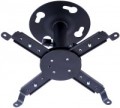Max. weight
Each bracket is designed to withstand a specific weight indefinitely without any consequences. But the safety of its use is not guaranteed if the user exceeds this maximum weight. This does not mean that the bracket will collapse immediately, as soon as you reload it, but this can happen at any time, and such a breakdown is no longer covered by the warranty. Note that the weight of the lightest projectors is about 5 kg, while the weight of professional equipment can exceed 50 kg. Experts recommend purchasing mounts which maximum weight is 20% higher than the weight of the projector.
As for projector stands, here you need to understand that the maximum weight does not mean the weight of the projector that can be installed on the stand, but the total weight of all objects located on it.
Minimum distance from the ceiling
The minimum allowable distance from the ceiling to the nearest protruding attachment point at its highest position. This parameter is primarily important for ceiling mounts, it indicates how close to the ceiling the user can place the projector. If the projector cannot be adjusted in height, then this parameter corresponds to the bracket rod length..
Max. distance from the ceiling
The maximum allowable distance from the ceiling to the nearest protruding attachment point in its lowest position. This setting primarily applies to ceiling mounts and indicates how low the mount can be lowered from the ceiling with the projector mounted on it. It is recommended to mount the projector at the same height as the top edge of the screen. Note that if the design does not provide the possibility of adjusting the height, then this parameter corresponds to the length of the rod.
Adjustments
In most cases, all projector mounts are made in the form of a special movable mechanism that allows the user to adjust the position of the projector relative to the space of the room or the user himself, even after the device is installed on the bracket and the bracket is mounted on the wall. The more adjustment options available, the more convenient the mount can be for home use, as it will allow user to optimally adjust the position of the projector. But there can be a significant difference in price between brackets that are almost identical in appearance, primarily due to additional adjustment options.
—
tilt. The projector can be tilted forward or backward to direct the light at the desired angle if the device is above or below the user's eye level. This parameter is very important for projectors that will be installed much lower or higher than the screen, for example, under the ceiling.
—
turn. In this case, it means that the projector that already mounted on the bracket can be tilted a few degrees to the left or right relative to a horizontal line or ceiling. This feature will be very useful if the device is installed in a room with an uneven ceiling.
—
depth adjustment. The ability to move the projector back and forth relative to the point of attachment to the wall. In fact, this allows you to push the projector towards you, or vice versa
...— move it closer to the wall. On its own, this setting has little effect, but when combined with rotation (see "Rotation"), it can improve the usability of the bracket.
— height adjustment. The ability to adjust the height of the projector relative to the point of attachment to the wall. This parameter is of particular importance for ceiling mounts; it is implemented by an adjustable telescopic rod. All modern ceiling mounts can be divided into two broad categories: with a rigid rod of a fixed length and with an adjustable rod.
— rotation. Ability to rotate the projector from side to side around the vertical axis. It can be important if the projection screen can eventually be moved to the other side of the room — in this case, instead of removing the mount itself, user can simply rotate the projector mounted on it. It is also important if the projector is not exactly centered on the projection screen after installation.Upward tilt angle
The maximum tilt angle of the platform on which the projector is installed is up from the vertical. If it is a ceiling mount, then this feature, usually, remains unclaimed, in contrast to the possibility of tilting down. But for wall mounting, it can be useful, depending on the location of the mount relative to the projection screen.
Downward tilt angle
The maximum tilt angle of the platform with the projector down relative to the vertical. So, if it is a ceiling bracket, then a large tilt angle will provide wider possibilities when choosing an installation location.
Rotation angle
The possibility of rotation of a projector relative to a vertical axis or a rod is provided. For the vast majority of mounts that have the ability to rotate an already installed projector, this figure is 360°, which allows you to rotate the projector around the rod and direct the light to the desired side of the room.
Cable management
Capability of cable management inside the rod or mounting support in such a way that the cables do not create inconvenience and do not spoil the appearance of the structure. This possibility is provided mainly in modern ceiling and wall models.

